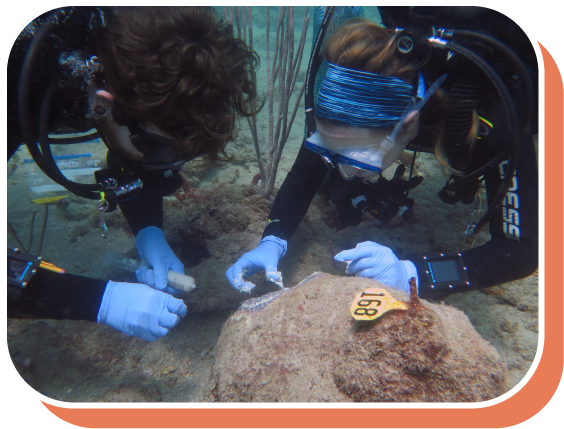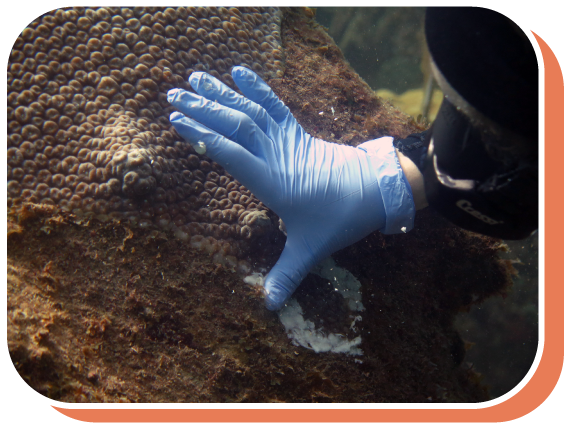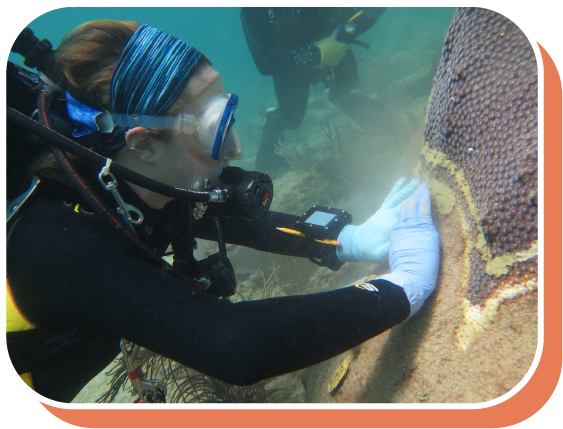For almost a decade, a lethal and highly contagious disease has impacted the corals of Florida’s 350-mile coral reef, which stretches from Dry Tortugas National Park, west of the Florida Keys, to the St. Lucie Inlet in Martin County. Now, researchers at FAU’s Harbor Branch Oceanographic Institute have found a promising treatment — antibiotics.
Stony coral tissue loss disease was first observed in 2014 in Miami-Dade County after a dredging event and has since spread throughout the majority of the Florida Reef Tract, as well as multiple countries and territories in the Caribbean. It’s impacted more than 20 species of hard corals — those that build their own limestone skeletons — like brain, pillar and star corals. Using an amoxicillin treatment, however, the scientists could heal individual disease lesions with a success rate of about 95%, based on the results of their study, recently published in Scientific Reports.
“This particular disease is really impactful in terms of the rate at which it has spread geographically, the number of coral host species that it can infect and the amount of corals that are being lost to it,” said Joshua Voss, Ph.D., an associate research professor at Harbor Branch, and senior author of the new study. “Those things combined made it too gut-wrenching to stand by and not try to come up with some kind of effort to combat it.”
Voss and the team experimentally tested two different treatment options, chlorinated epoxy and amoxicillin on the Great Star Coral at sites 1.2 miles offshore from Lauderdale-by-the-Sea in Broward County. They chose Great Star Coral because it’s one of the most important reef builders in the region. Divers got in the water and applied the treatments to lesions on the corals, which were then monitored over a period of 11 months.
A single dose of the amoxicillin treatment had a 95 percent success rate at healing individual disease lesions. However, it did not necessarily prevent treated colonies from developing new lesions over time. The chlorinated epoxy did nothing to help or treat the disease.
“I did not expect such a high success rate on treating the individual lesions after almost a year,” said Erin Shilling, who led the study for her master’s thesis research, and is currently the lab manager for Voss’ team. “That was very promising.”
Knowing now that this treatment can be effective, the next step is to assess any potential impacts of the antibiotics on the general bacterial community of the corals. This way, once this treatment is scaled up further, we can know we’re doing so responsibly, Shilling said.
Globally, coral reefs cover nearly 110,039 square miles of the seafloor and are among the most diverse ecosystems on the planet. Without intervention, some experts estimate coral reefs will disappear entirely by 2100. Disease is just one of the many threats corals face, along with rising temperatures and changing environmental conditions.
“If we get innovative and creative, we can come up with solutions,” Voss said. “But this approach is just one tool of many diverse management options for addressing coral losses overall. We need to continue work on climate change, to have any hope of corals surviving long term. We also need to continue work on water quality improvements, particularly here in Florida, as well as exploring restoration approaches and other conservation measures that can help coral reefs to stay healthy in the first place.” ⬥





